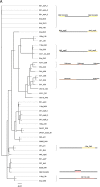Distribution of cp32 prophages among Lyme disease-causing spirochetes and natural diversity of their lipoprotein-encoding erp loci
- PMID: 23624478
- PMCID: PMC3697573
- DOI: 10.1128/AEM.00817-13
Distribution of cp32 prophages among Lyme disease-causing spirochetes and natural diversity of their lipoprotein-encoding erp loci
Abstract
Lyme disease spirochetes possess complex genomes, consisting of a main chromosome and 20 or more smaller replicons. Among those small DNAs are the cp32 elements, a family of prophages that replicate as circular episomes. All complete cp32s contain an erp locus, which encodes surface-exposed proteins. Sequences were compared for all 193 erp alleles carried by 22 different strains of Lyme disease-causing spirochete to investigate their natural diversity and evolutionary histories. These included multiple isolates from a focus where Lyme disease is endemic in the northeastern United States and isolates from across North America and Europe. Bacteria were derived from diseased humans and from vector ticks and included members of 5 different Borrelia genospecies. All erp operon 5'-noncoding regions were found to be highly conserved, as were the initial 70 to 80 bp of all erp open reading frames, traits indicative of a common evolutionary origin. However, the majority of the protein-coding regions are highly diverse, due to numerous intra- and intergenic recombination events. Most erp alleles are chimeras derived from sequences of closely related and distantly related erp sequences and from unknown origins. Since known functions of Erp surface proteins involve interactions with various host tissue components, this diversity may reflect both their multiple functions and the abilities of Lyme disease-causing spirochetes to successfully infect a wide variety of vertebrate host species.
Figures








References
-
- Fraser CM, Casjens S, Huang WM, Sutton GG, Clayton R, Lathigra R, White O, Ketchum KA, Dodson R, Hickey EK, Gwinn M, Dougherty B, Tomb J-F, Fleischmann RD, Richardson D, Peterson J, Kerlavage AR, Quackenbush J, Salzberg S, Hanson M, van Vugt R, Palmer N, Adams MD, Gocayne J, Weidmann J, Utterback T, Watthey L, McDonald L, Artiach P, Bowman C, Garland S, Fujii C, Cotton MD, Horst K, Roberts K, Hatch B, Smith HO, Venter JC. 1997. Genomic sequence of a Lyme disease spirochaete, Borrelia burgdorferi. Nature 390:580–586 - PubMed
-
- Casjens S, Palmer N, van Vugt R, Huang WM, Stevenson B, Rosa P, Lathigra R, Sutton G, Peterson J, Dodson RJ, Haft D, Hickey E, Gwinn M, White O, Fraser C. 2000. A bacterial genome in flux: the twelve linear and nine circular extrachromosomal DNAs of an infectious isolate of the Lyme disease spirochete Borrelia burgdorferi. Mol. Microbiol. 35:490–516 - PubMed
-
- Casjens SR, Eggers CH, Schwartz I. 2010. Borrelia genomics: chromosome, plasmids, bacteriophages and genetic variation, p 27–54 In Samuels DS, Radolf JD. (ed), Borrelia: molecular biology, host interaction and pathogenesis. Caister Academic Press, Norfolk, United Kingdom
Publication types
MeSH terms
Substances
Associated data
- Actions
- Actions
- Actions
- Actions
- Actions
- Actions
- Actions
- Actions
- Actions
- Actions
Grants and funding
LinkOut - more resources
Full Text Sources
Other Literature Sources

